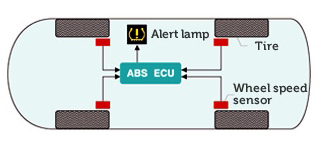Working Of Tyre Pressure Monitoring System:
Tyre Pressure Monitoring System or TPMS is an electronic system which monitors the pressure of air in the tyres of the vehicle. TPMS checks the tyre pressure continuously and informs the driver if tyres are underinflated or overinflated. A few years ago, only on the luxury vehicles offered this system. However, now it is rapidly gaining popularity among the other vehicles.
Functions of Tyre Pressure Monitoring System:
- To check the tyre pressure continuously.
- To inform the driver about the wrong tyre pressure.
Types of Tyre Pressure Monitoring System:
TPMS are mainly classified into two different types viz. Indirect TPMS and Direct TPMS.
Indirect Tyre Pressure Monitoring System:

This system does not directly measure the pressure of air in the tyres. Instead, it relies on measuring the angular speed of the tyres and from that judges the tyre pressure. This measurement works on the simple principle that the under-inflated tyre will have higher angular velocity due to its small size and vice versa. As this system does not carry out any direct pressure measurement, it does not employ the air pressure sensor. Some systems of this type may also measure the difference in the pressures of the two tyres i.e. differential pressure. Generally, Indirect Tyre Pressure Monitoring System uses the data generated by the speed sensors of ABS or ESP.
Nowadays, highly specialized software process the data generated by the speed sensors. Thus, they increase the accuracy of the system.
Direct Tyre Pressure Monitoring System:

This system measures the absolute tyre pressure in each tyre of the vehicle with the help of the air pressure sensor fitted either internal or external to the tyre. These sensors then transmit the data to the central monitoring system which ultimately transfers it to the ECU of the vehicle where it is processed and a warning is given to the driver if any problem is observed. Some of the systems of this type are also capable of measuring the temperature of air in the tyres.

Advantages of using Tyre Pressure Monitoring System:
- Improves safety: Under-inflated or over-inflated tyres severely hamper the steering accuracy and hence such a vehicle is more prone to accidents. By warning the driver about the wrong tyre pressure, TPMS improves the safety of the vehicle.
- Improves fuel efficiency: Correct tyre pressure ensures the lower rolling resistance to tyres and hence fuel efficiency of the vehicle is improved.
For more information, please click here.
Read more: What is an asymmetric tyre?>>
